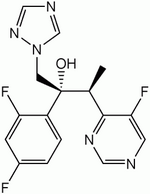The FDA has approved new indications for voriconazole injection, tablets, and oral suspension (VFEND, made by Pfizer, Inc.), expanding its use in the treatment of candidemia and candidal infections in non-neutropenic patients including disseminated skin infections. Voriconazole is a triazole anti-fungal agent. The primary mode of action of voriconazole is inhibition of fungal cytochrome P-450-mediated 14 alpha-lanosterol demethylation, an essential step in fungal ergosterol biosynthesis.
The approval followed results from a randomized, comparative study involving 422 non-neutropenic patients with candidemia and clinical signs of infection. The study demonstrated that voriconazole was as effective as amphotericin B (followed by fluconazole) therapy in achieving a successful response, as defined by resolution or improvement of all clinical signs of infection at 3 months (41% for both). Median treatment time was 15 days.
The most frequently reported adverse events associated with therapy included visual disturbances, fever, rash, vomiting, nausea, diarrhea, headache, sepsis, peripheral edema, abdominal pain, and respiratory disorders. Discontinuation of therapy was most commonly a response to elevated liver enzyme levels, rash, and visual disturbances.
Voriconazole has previously gained FDA-approval for the treatment of invasive aspergillosis, esophageal candidiasis, and as salvage therapy for fungal infections caused by Scedosporium apiospermum and Fusarium species pathogens.
COPYRIGHT 2005 Journal of Drugs in Dermatology, Inc.
COPYRIGHT 2005 Gale Group



